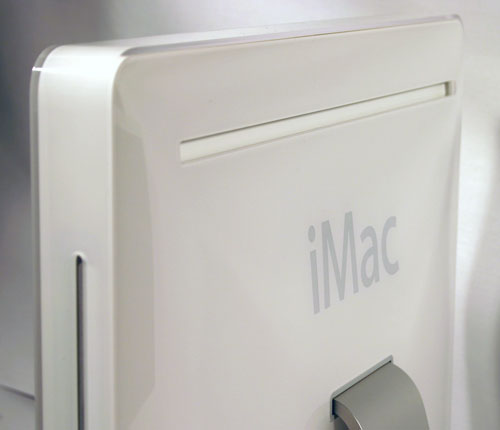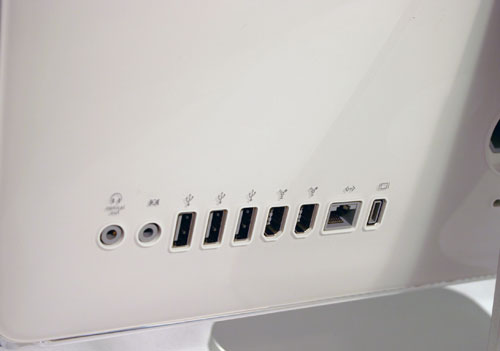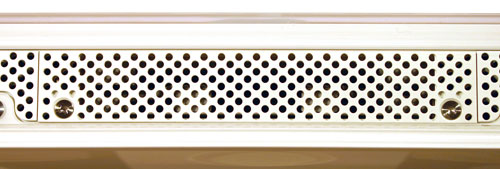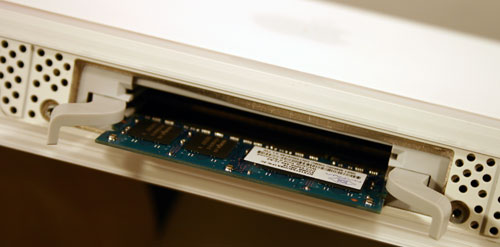Apple Makes the Switch: iMac G5 vs. iMac Core Duo
by Anand Lal Shimpi on January 30, 2006 11:26 PM EST- Posted in
- Mac
The new iMac
 Although my wife has been using one for a while, I realized that I have never actually given my impressions of Apple's iMac platform, despite having looked at both their desktop and notebook offerings in my initial wave of Mac articles.
Although my wife has been using one for a while, I realized that I have never actually given my impressions of Apple's iMac platform, despite having looked at both their desktop and notebook offerings in my initial wave of Mac articles.
The iMac is an interesting option for the desktop user, as it is very much a "lifestyle" computer, but a very functional and capable one at that. The iMac is the epitome of what today's PC makers simply do not create - and that is a modern, stylish take on the desktop computer.
It has been done many times in the past. You combine a monitor with a computer and sell it as one. It was done so frequently and so poorly in the past on PCs that there is now a stigma associated with it, but let's think about that for a moment; some of the worst all-in-one designs came about well before LCD panels became mainstream, not to mention that user upgradability was a much bigger deal back then than it is today. With the advent of the LCD panel, you can actually have some pretty stylish integrated systems, if you design them properly, that is. And the issue of upgradability is far less of a demand today than it was back then for a number of reasons: the rate at which CPUs are released has slowed down tremendously, external storage is extremely easy to add, and if you aren't a gamer, then a good GPU today will last you years to come. The point is that these integrated designs were mostly terrible in the past, but that doesn't mean that they have to be today.
When Apple released the Mac mini, I looked at it and thought that they had struck gold; they basically took a notebook platform, massaged the shape, and stuck it in a wonderful form factor for the casual desktop user. In the process, you lose the ease of internal access that larger form factors would offer, but the end result is very close to the perfect form factor for casual users. With the iMac, Apple has pretty much done the same thing; they've taken a notebook motherboard and processor, although this time combined it with a 3.5" desktop hard drive, and mounted it behind a LCD panel - creating a very elegant desktop computer.
The trick to the iMac is in its form factor - although the design is a little bottom heavy, the iMac doesn't look all that much different than your standard LCD monitor. The very positive side effect of the iMac's integrated design is that when paired with a Bluetooth keyboard and mouse, you only have a single cable coming out of the system for power and that's all. The iMac has made it OK for a computer to be on top of your desk again, with as little as one cable coming out of the system - the days of a wiring nest collecting dust behind your computer are over. Granted, this machine isn't for everyone, and I definitely couldn't use it as my only computer simply because I would need a higher resolution panel attached to it, but as a second or third computer, or a computer for someone who just wants the basics (Web browsing, email, documents, music, photos, movies, etc.), the iMac does suffice.
Apple has done the bare minimum and outfitted these two systems with 512MB of memory. I mention that 512MB is the bare minimum because it honestly is for OS X, but I will mention that one of the first upgrades that I would perform on these machines is to bring them up to 1GB of memory. With only 512MB, there were a number of cases during my normal use of the machines (which, in this instance, didn't include any heavy multitasking) where I found them swapping to disk. Just browsing the web or checking email didn't trigger it, but it was once I started to really use any of the iLife '06 or iWork '06 applications that 512MB quickly became a burden.
Upgrading the memory on the iMac is about the only thing that you can do, as replacing the hard drive requires a complete disassembly of the machine (which isn't something that Apple wants end users to do - they would like you to bring it into their stores for those sorts of upgrades). Thankfully, upgrading the memory on the machine is fairly easy. Along the bottom of the machine, there are two screws that you can remove with a small screwdriver. Removing these screws releases a panel that covers either one or two slots for memory, depending on which iMac you own.
 Although my wife has been using one for a while, I realized that I have never actually given my impressions of Apple's iMac platform, despite having looked at both their desktop and notebook offerings in my initial wave of Mac articles.
Although my wife has been using one for a while, I realized that I have never actually given my impressions of Apple's iMac platform, despite having looked at both their desktop and notebook offerings in my initial wave of Mac articles. The iMac is an interesting option for the desktop user, as it is very much a "lifestyle" computer, but a very functional and capable one at that. The iMac is the epitome of what today's PC makers simply do not create - and that is a modern, stylish take on the desktop computer.
It has been done many times in the past. You combine a monitor with a computer and sell it as one. It was done so frequently and so poorly in the past on PCs that there is now a stigma associated with it, but let's think about that for a moment; some of the worst all-in-one designs came about well before LCD panels became mainstream, not to mention that user upgradability was a much bigger deal back then than it is today. With the advent of the LCD panel, you can actually have some pretty stylish integrated systems, if you design them properly, that is. And the issue of upgradability is far less of a demand today than it was back then for a number of reasons: the rate at which CPUs are released has slowed down tremendously, external storage is extremely easy to add, and if you aren't a gamer, then a good GPU today will last you years to come. The point is that these integrated designs were mostly terrible in the past, but that doesn't mean that they have to be today.
When Apple released the Mac mini, I looked at it and thought that they had struck gold; they basically took a notebook platform, massaged the shape, and stuck it in a wonderful form factor for the casual desktop user. In the process, you lose the ease of internal access that larger form factors would offer, but the end result is very close to the perfect form factor for casual users. With the iMac, Apple has pretty much done the same thing; they've taken a notebook motherboard and processor, although this time combined it with a 3.5" desktop hard drive, and mounted it behind a LCD panel - creating a very elegant desktop computer.
The trick to the iMac is in its form factor - although the design is a little bottom heavy, the iMac doesn't look all that much different than your standard LCD monitor. The very positive side effect of the iMac's integrated design is that when paired with a Bluetooth keyboard and mouse, you only have a single cable coming out of the system for power and that's all. The iMac has made it OK for a computer to be on top of your desk again, with as little as one cable coming out of the system - the days of a wiring nest collecting dust behind your computer are over. Granted, this machine isn't for everyone, and I definitely couldn't use it as my only computer simply because I would need a higher resolution panel attached to it, but as a second or third computer, or a computer for someone who just wants the basics (Web browsing, email, documents, music, photos, movies, etc.), the iMac does suffice.



All of the ports are on the back of the system.
Apple has done the bare minimum and outfitted these two systems with 512MB of memory. I mention that 512MB is the bare minimum because it honestly is for OS X, but I will mention that one of the first upgrades that I would perform on these machines is to bring them up to 1GB of memory. With only 512MB, there were a number of cases during my normal use of the machines (which, in this instance, didn't include any heavy multitasking) where I found them swapping to disk. Just browsing the web or checking email didn't trigger it, but it was once I started to really use any of the iLife '06 or iWork '06 applications that 512MB quickly became a burden.
Upgrading the memory on the iMac is about the only thing that you can do, as replacing the hard drive requires a complete disassembly of the machine (which isn't something that Apple wants end users to do - they would like you to bring it into their stores for those sorts of upgrades). Thankfully, upgrading the memory on the machine is fairly easy. Along the bottom of the machine, there are two screws that you can remove with a small screwdriver. Removing these screws releases a panel that covers either one or two slots for memory, depending on which iMac you own.


The 200-pin DDR2 SO-DIMM in the Intel based iMac.










35 Comments
View All Comments
Anand Lal Shimpi - Tuesday, January 31, 2006 - link
Turning off one core leaves the full 2MB of cache for the other core to use since it is a shared L2.Take care,
Anand
Eug - Tuesday, January 31, 2006 - link
Cool thanks.
P.S. I have read elsewhere that the new iMac Core Duo uses less than half of the CPU's processing power to play back H.264 Hi-Def 1920x1080 video at a full 24 fps. If true, that's great, because my iMac 2.0 chokes on that. It plays back relatively smoothly, but only at about 12-15 fps.
That bodes well for a future single-core Yonah Mac mini.
Then again, probably not, considering that I suspect the iMac Core Duo does so well on H.264 playback because of its Radeon X1600. I'd doubt the Mac mini would get anything close to that any time soon.
Anand Lal Shimpi - Tuesday, January 31, 2006 - link
Max CPU utilization (across both CPUs) when playing a 1080p stream scaled to fit the screen is about 60%, but it usually hovers below 50%. I am not sure whether or not the X1600's H.264 decode acceleration is taken advantage of (I doubt it), I'm trying to find out now. Also remember that on the PC side, the X1600 will only accelerate up to 720p.Take care,
Anand
Anand Lal Shimpi - Tuesday, January 31, 2006 - link
I just confirmed with ATI, the X1600's H.264 decode acceleration is currently not supported under OS X. ATI is working with Apple on trying to get the support built in, but currently it isn't there.Take care,
Anand
Eug - Tuesday, January 31, 2006 - link
Thanks again for the info. That's actually good news in a way. Things are looking up for that single-core Yonah Mac mini HTPC.
andrep74 - Tuesday, January 31, 2006 - link
Isn't performance/Watt a function of the CPU, not the platform?Kyteland - Tuesday, January 31, 2006 - link
That picture of Jobs doesn't say "PC vs Intel" it says "PowerPC vs Intel". Jobs is just standing in the way. He's comparing the old mac to the new mac.Calin - Tuesday, January 31, 2006 - link
You could think about it that way - but in the end, the buyer is interested on the total energy consumption/heat production (as this is what he pays for, and what he must get rid of).Have you heard of the Toyota D4D engine? It has a record of 2.4 liter (less than a gallon) diesel fuel used per a hundred kilometers (60 miles). However, the same engine on a Land Cruiser 4x4 all options will get you much less (four times less maybe).
It doesn't worths talking about performance per watt at the processor level, it is better at the platform level.
BUBKA - Tuesday, January 31, 2006 - link
Were these benches done with a USB 2.0 device plugged in?Furen - Tuesday, January 31, 2006 - link
I was under the impression that Intel was blaming Microsoft for that, so that would not apply to OSX, though if the driver works perfectly for every platform except Napa I'd guess its a hardware problem that MS will fix in software (which is well enough as long as it works). The power consumption difference is probably less than 10W anyway. It matters on a notebook but hardly matters with a desktop.